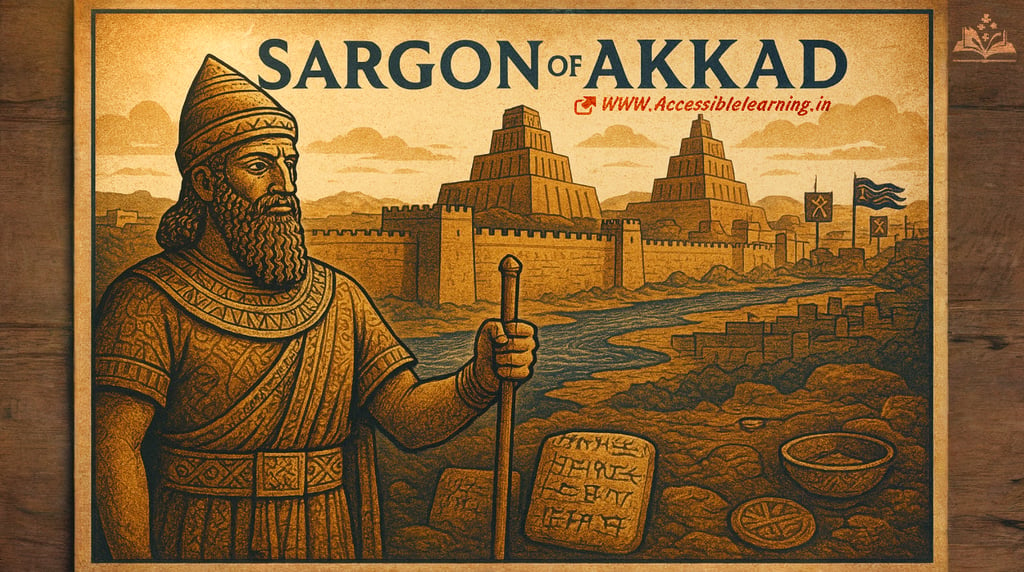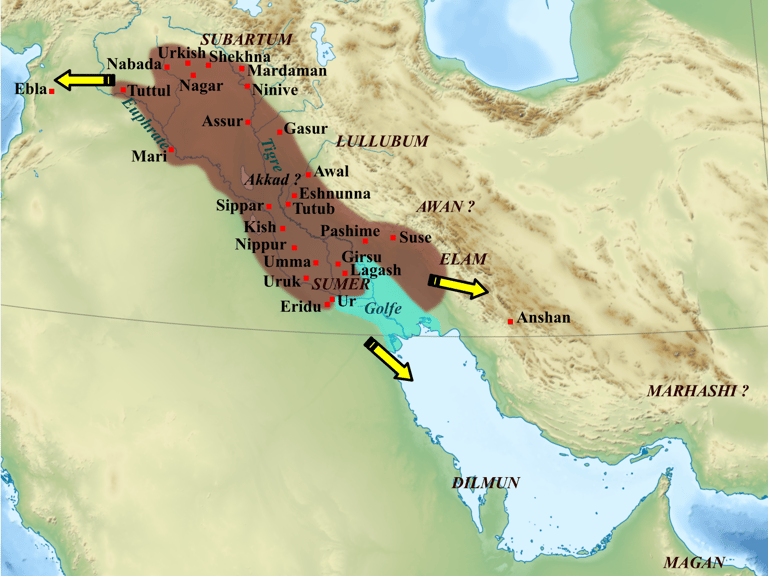
The Akkadian Empire: The Complete Guide to History's First Empire (2340-2154 BCE)
Discover the Akkadian Empire (2340-2154 BCE), history's first empire. Explore Sargon's conquests, imperial innovations, and lasting legacy in ancient Mesopotamia.
EMPIRES/HISTORYHISTORY
Keshav Jha
8/17/20257 min read


The Akkadian Empire (circa 2340-2198 BCE) represented something entirely new in human history: a dynasty that conquered and ruled over a vast territory, incorporating people of different ethnicities who were forced to adopt its ways. This first known empire succeeded the long-lived city-states of Sumer and united Akkadian and Sumerian speakers under one rule.
The significance of the Akkadian Empire extends far beyond its chronological primacy. This ancient Mesopotamian civilization established fundamental precedents for imperial governance, military organization, and cultural integration that would influence empires throughout human history. Recent archaeological discoveries continue to shed new light on this foundational civilization, revealing the sophisticated administrative systems and cultural achievements that made the Akkadian Empire a transformative force in the ancient world.
The Rise of Sargon of Akkad: From Cupbearer to Emperor
Sargon's Legendary Origins
Sargon of Akkad, founder of the "Sargonic" or "Old Akkadian" dynasty, began his rise to power as a cupbearer to King Ur-Zababa of Kish before becoming king himself. The story of Sargon's ascension has become legendary in ancient literature, with the Sargon Birth Legend describing his humble origins and miraculous survival as an infant.
Archaeological evidence supports the historical existence of Sargon, though the capital city of Akkad itself remains archaeologically unidentified. Recent scholarly work has focused on understanding how this remarkable leader transformed from a court official to the architect of history's first multi-ethnic empire.
Military Conquests and Imperial Expansion
Sargon's empire, which he ruled from his capital, Akkad, is thought to have included most of Mesopotamia and parts of the Levant, as well as Hurrian and Elamite territory. His military campaigns were revolutionary in scope and organization, establishing patterns of conquest and administration that future empires would emulate.
The Akkadian military machine was notably effective due to its combination of traditional Mesopotamian warfare tactics with innovative organizational structures. Sargon's forces successfully conquered major Sumerian city-states, including Ur, Uruk, and Lagash, integrating these urban centers into a unified administrative system.
Geographical Extent and Administrative Organization
Territorial Reach of the Akkadian Empire
At its height, the empire encompassed much of modern Iraq and parts of Syria, though its heartland is believed to have been the fertile plains of central Mesopotamia watered by the Tigris and Euphrates rivers. The empire exercised significant influence across Mesopotamia, the Levant, and Anatolia, sending military expeditions as far south as Dilmun and Magan (modern United Arab Emirates, Saudi Arabia, Bahrain, Kuwait, Qatar, and Oman) in the Arabian Peninsula.
This vast territorial control required sophisticated administrative systems to manage diverse populations and maintain imperial unity. The Akkadians developed innovative approaches to governance that balanced central authority with local autonomy, allowing conquered territories to retain certain cultural practices while adopting Akkadian administrative standards.
Administrative Innovations and Governance
The Akkadian Empire pioneered several administrative innovations that became standard practice in subsequent empires. These included standardized weights and measures, unified legal codes, and systematic record-keeping using cuneiform script. The empire's administrative structure relied heavily on appointed governors who reported directly to the imperial court, establishing clear chains of command across the vast territory.
Archaeological evidence reveals that the Akkadians implemented comprehensive taxation systems and maintained detailed records of agricultural production, trade transactions, and military expenditures. This bureaucratic sophistication enabled the empire to function effectively despite its unprecedented size and diversity.


Cultural and Linguistic Impact
The Akkadian Language Legacy
The Akkadian language, a Semitic language written in cuneiform script, became the lingua franca of ancient Mesopotamia and remained influential for over two millennia. This linguistic standardization facilitated trade, diplomacy, and cultural exchange across the ancient Near East, establishing communication networks that persisted long after the empire's collapse.
Akkadian literary traditions, including epic poetry and historical chronicles, preserved and transmitted cultural knowledge throughout the ancient world. The influence of Akkadian literature can be traced in later Babylonian and Assyrian texts, demonstrating the enduring cultural impact of this early imperial civilization.
Religious & Cultural Integration
The Akkadian Empire's approach to religious and cultural diversity was notably sophisticated for its time. Rather than imposing uniform religious practices, the Akkadians typically incorporated local deities into their pantheon while promoting their own religious traditions. This syncretic approach helped maintain stability across culturally diverse territories.
Archaeological finds include cylinder seals, which depict scenes of daily life and divine patronage, illustrating the interconnectedness of governance, religion, and artistry during this period. These artifacts serve as primary evidence of the cultural and administrative advancements achieved under Sargon.
Recent Archaeological Discoveries and Research
Contemporary Archaeological Findings
A very important city was recently unearthed in Northern Iraq by an international team of archaeologists from the University of Tübingen, providing new insights into Bronze Age urban development during the Akkadian period. These recent excavations continue to reveal the sophisticated urban planning and architectural achievements of Akkadian civilization.
Current research focuses on the third millennium BC Akkadian imperial penetration of the north Mesopotamian plain, which represents the terminus of the village-state-empire trajectory of sixth to third millennium BC West Asia. This ongoing scholarly work helps contextualize the Akkadian Empire within broader patterns of ancient Near Eastern development.
Ongoing Research Projects
Contemporary archaeological projects continue to investigate Akkadian sites across Mesopotamia, utilizing advanced technologies including satellite imaging, ground-penetrating radar, and digital mapping systems. These modern archaeological methods are revealing previously unknown aspects of Akkadian urban planning, trade networks, and cultural practices.
The integration of textual analysis with archaeological evidence has enhanced understanding of Akkadian administrative practices, economic systems, and social structures. Recent discoveries of administrative archives provide detailed insights into the daily operations of imperial governance.
The Fall of the Akkadian Empire
Factors in Imperial Decline
The collapse of the Akkadian Empire around 2154 BCE resulted from multiple converging factors, including climate change, internal rebellions, and external invasions. Archaeological evidence suggests that severe drought conditions contributed to agricultural failure and social instability throughout the empire's territory.
The Gutian invasions from the Zagros Mountains ultimately overwhelmed Akkadian military defenses, leading to the fragmentation of imperial control. This period of instability marked the end of centralized Akkadian authority, though Akkadian cultural and linguistic influences persisted in subsequent Mesopotamian civilizations.
Environmental and Climate Factors
Recent paleoclimate research has identified significant aridification events that coincided with the empire's decline. These climate changes affected agricultural productivity throughout Mesopotamia, undermining the economic foundation of imperial administration. The relationship between environmental stress and political instability in the Akkadian Empire provides important insights into the vulnerability of ancient civilizations to climate variation.
Legacy and Historical Significance
Influence on Later Empires
The administrative innovations, military strategies, and cultural integration practices developed by the Akkadian Empire established enduring precedents for imperial governance. Subsequent empires, including the Babylonian, Assyrian, and Persian empires, adopted and adapted Akkadian imperial models, demonstrating the lasting influence of this pioneering civilization.
The Akkadian approach to managing cultural diversity within imperial frameworks provided successful strategies that were replicated throughout ancient history. These early experiments in multiethnic governance contributed to the development of imperial administration as a distinct form of political organization.
Modern Relevance and Understanding
Contemporary scholarship continues to reveal new aspects of Akkadian civilization that enhance understanding of early state formation, imperial administration, and cultural integration processes. The Akkadian Empire serves as a crucial case study for examining the development of complex political institutions and their relationship to technological, environmental, and social factors.
The study of Akkadian imperial practices provides valuable insights for understanding the dynamics of political integration, economic coordination, and cultural exchange in large-scale political systems. These historical lessons remain relevant for contemporary analysis of globalization, political integration, and cultural diversity management.

FAQ's
Q: What made the Akkadian Empire the first empire in history?
The Akkadian Empire is considered the first empire because it was the first political entity to successfully conquer and integrate multiple independent city-states and territories under unified central authority. Unlike previous political organizations that were limited to individual cities or small regions, the Akkadian Empire established administrative control over vast territories encompassing diverse populations and cultures.
Q: How long did the Akkadian Empire last?
The Akkadian Empire existed for approximately 180 years, from circa 2340 BCE to 2154 BCE. The empire reached its peak under Sargon of Akkad and his successors, maintaining imperial control for about a century after Sargon's death before succumbing to the Gutian conquest.
Q: Where was the capital city of Akkad located?
Despite extensive archaeological investigation, the exact location of Akkad, the empire's capital city, remains unknown. Scholars believe it was located somewhere in central Mesopotamia, possibly near modern Baghdad, but the site has not been definitively identified through archaeological excavation.
Q: What language did the Akkadians speak?
The Akkadians spoke Akkadian, a Semitic language that became the diplomatic and commercial lingua franca of the ancient Near East. Akkadian was written using cuneiform script and remained influential in the region for over two thousand years after the empire's collapse.
Q: How did the Akkadian Empire influence later civilizations?
The Akkadian Empire established fundamental precedents for imperial administration, military organization, and cultural integration that influenced all subsequent Near Eastern empires. The administrative systems, legal codes, and governance structures developed by the Akkadians were adopted and adapted by later Babylonian, Assyrian, and Persian empires.
Q: What caused the fall of the Akkadian Empire?
The Akkadian Empire collapsed due to multiple factors, including severe climate change and drought, internal rebellions, and invasions by the Gutians from the Zagros Mountains. Archaeological and paleoclimatic evidence suggests that environmental stress significantly weakened the empire's economic and military capabilities.
Q: What archaeological evidence exists for the Akkadian Empire?
Archaeological evidence for the Akkadian Empire includes cylinder seals, administrative tablets, architectural remains, and artistic artifacts discovered throughout Mesopotamia and surrounding regions. Recent excavations continue to reveal new insights into Akkadian urban planning, administrative practices, and cultural achievements.
Q: How did the Akkadians manage their diverse empire?
The Akkadians developed sophisticated administrative systems that balanced central authority with local autonomy. They appointed governors to oversee conquered territories, implemented standardized administrative practices, and adopted inclusive approaches to local religious and cultural traditions while promoting Akkadian imperial culture.
The Akkadian Empire represents a pivotal moment in human civilization, marking the transition from independent city-states to integrated imperial systems. Through innovative approaches to governance, military organization, and cultural integration, the Akkadians established the foundational model for imperial administration that would influence political development throughout ancient history.
Contemporary archaeological research continues to reveal new dimensions of Akkadian achievement, demonstrating the sophistication of their administrative systems, the extent of their cultural influence, and the complexity of their imperial organization. The study of the Akkadian Empire provides essential insights into the development of complex political institutions and their relationship to technological, environmental, and social factors.
Understanding the Akkadian Empire's rise, achievements, and eventual decline offers valuable perspectives on the dynamics of political integration, the management of cultural diversity, and the relationship between environmental factors and political stability. As the world's first empire, the Akkadian civilization established precedents and patterns that continue to inform our understanding of imperial systems and their historical significance.
The legacy of the Akkadian Empire extends far beyond its chronological boundaries, encompassing contributions to language, literature, law, administration, and cultural integration that shaped the development of ancient Near Eastern civilization. Through continued archaeological investigation and scholarly analysis, our understanding of this foundational empire continues to evolve, revealing new insights into the origins of imperial governance and the complex factors that shape the rise and fall of civilizations.
Subscribe To Our Newsletter
All © Copyright reserved by Accessible-Learning Hub
| Terms & Conditions
Knowledge is power. Learn with Us. 📚


